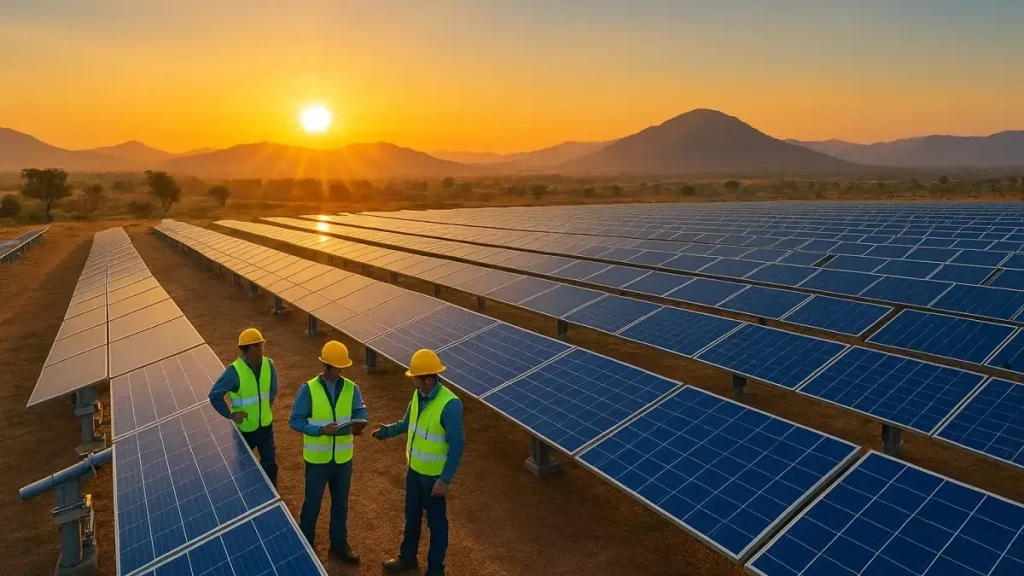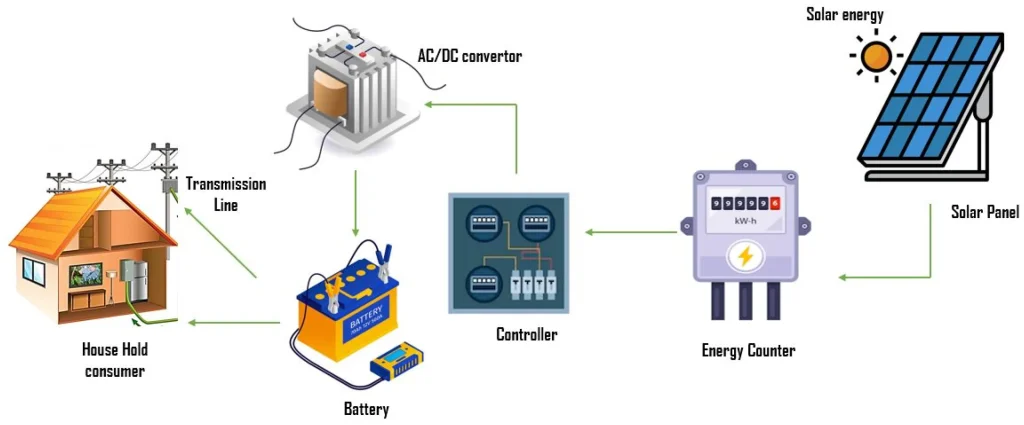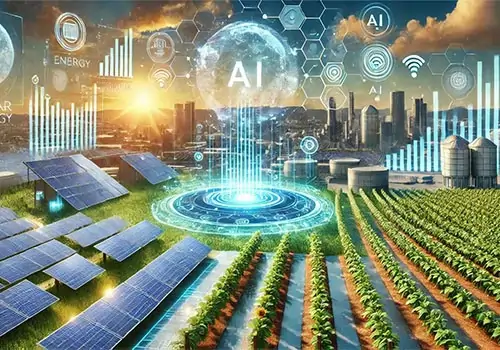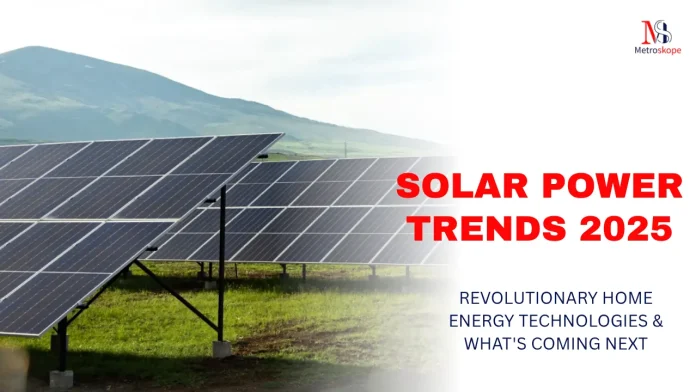If you thought 2024 was the year of solar, buckle up buttercup—2025 is serving up solar innovations that make last year’s panels look like calculator screens from the 90s.
We’re talking 50% efficiency improvements, AI-powered energy management, and solar tech so advanced it might just achieve sentience and start paying your electricity bills.
The home solar industry is experiencing what experts call a “technological crescendo“—where multiple breakthrough innovations are converging faster than Marvel superheroes in an Avengers movie.
And unlike those movies, this one actually makes sense and will save you money.
Why 2025 Is Solar’s Breakout Year
The Perfect Storm of Innovation
2025 has become the confluence point where several game-changing technologies are finally hitting mainstream adoption:
- Perovskite-silicon tandem cells achieving 35%+ efficiency
- AI-powered smart inverters optimizing performance in real-time
- Next-gen battery storage with 15-year lifespans
- Building-integrated photovoltaics (BIPV) that look better than traditional roofing
- Agrivoltaics for homeowners with larger properties
Translation: Your home is about to become a high-tech energy factory that’s prettier and smarter than ever before.
Market Reality Check: The Numbers Don’t Lie
2025 Solar Market Snapshot:
- Residential installations up 67% from 2024
- Average system costs down 23% due to tech improvements
- Efficiency improvements making smaller systems more powerful
- Battery adoption rate jumped from 12% to 47% of new installations
- Smart home integration now standard in 89% of systems
Revolutionary Technologies Reshaping Home Solar

1. Perovskite-Silicon Tandem Cells: The Efficiency Champions
What’s the big deal? Traditional silicon panels max out around 22% efficiency. Perovskite tandems are hitting 35%+ and climbing.
How it works:
- Dual-layer design captures more of the solar spectrum
- Top perovskite layer handles blue/UV light
- Bottom silicon layer processes red/infrared light
- Result: More power from the same roof space
Real-world impact:
- Same roof area produces 60% more electricity
- Smaller systems needed for whole-home power
- Better performance in low-light conditions
- ROI improved by 3-5 years
Availability: Oxford PV and First Solar launching consumer versions Q4 2025
Price premium: 15-25% over traditional panels (but higher output per panel)
2. AI-Powered Energy Management: Your Solar System Gets Smart
The old way: Panels generate power, you use it or sell it back to the grid
The 2025 way: AI optimizes everything in real-time based on weather, usage patterns, and energy prices
Smart features include:
- Weather prediction optimization adjusting battery charging schedules
- Dynamic load balancing prioritizing high-efficiency appliances during peak production
- Predictive maintenance alerting you before issues occur
- Market-responsive trading automatically selling excess power when prices peak
Leading platforms:
- Tesla’s Neural Network inverters
- SolarEdge’s AI-powered optimizers
- Enphase’s machine learning microinverters
Cool factor: Your solar system literally learns your family’s habits and optimizes accordingly
3. Next-Generation Battery Storage: Power When You Need It
2025’s battery revolution is solving the biggest solar limitation: what happens when the sun doesn’t shine?
Game-changing improvements:
- Lithium Iron Phosphate (LFP) batteries lasting 6,000+ cycles
- Solid-state battery pilots offering 2x energy density
- Modular systems allowing easy capacity expansion
- Vehicle-to-home integration using your EV as backup power
Top 2025 Battery Systems:
| System | Capacity | Lifespan | Price Range | Special Feature |
|---|---|---|---|---|
| Tesla Powerwall 3 | 13.5 kWh | 20 years | $8,500-$12,000 | Integrated inverter |
| Enphase IQ Battery 5P | 5 kWh | 15 years | $4,000-$6,000 | Modular expansion |
| Generac PWRcell M6 | 18 kWh | 10 years | $12,000-$15,000 | Weather-resistant |
| Sonnen Core+ | 10-20 kWh | 25 years | $15,000-$25,000 | German engineering |
4. Building-Integrated Photovoltaics (BIPV): Solar That Actually Looks Good
The aesthetic problem: Traditional panels look like… well, panels bolted to your roof
The 2025 solution: Solar becomes your roof, walls, and windows
BIPV innovations:
- Solar shingles indistinguishable from premium roofing
- Transparent solar windows generating power while maintaining views
- Solar siding for whole-wall energy generation
- Solar carports and pergolas providing shade AND power
Leading BIPV options:
- Tesla Solar Roof (Gen 4): $18-22 per square foot installed
- GAF Timberline Solar shingles: $12-16 per square foot
- Onyx Solar transparent panels: Custom pricing
- Sistine Solar designer panels: 15% premium over standard
5. Micro-Inverters and Power Optimizers: Maximum Performance
Old school: One central inverter for the entire system (failure = total shutdown)
2025 approach: Individual optimization for every single panel
Benefits:
- Shade tolerance: One shaded panel doesn’t kill the whole system
- Individual monitoring: Spot problems instantly
- Flexible installation: Panels can face different directions
- Better warranties: 25-year coverage standard
Market leaders:
- Enphase IQ8 microinverters with built-in AI
- SolarEdge HD-Wave optimizers with module-level monitoring
- Tigo TS4 optimizers with rapid shutdown safety
Cost Revolution: Solar Gets Cheaper AND Better

Price Trends That’ll Make Your Wallet Happy
2025 residential solar pricing:
- Average system cost: $2.50-$3.20 per watt (down from $3.80 in 2023)
- Typical 8kW system: $20,000-$25,600 before incentives
- After federal tax credit (30%): $14,000-$17,920
- With state/local incentives: Often under $10,000 net cost
Cost reduction drivers:
- Manufacturing scale reducing panel costs 40%
- Installation efficiency improvements cutting labor costs 25%
- Financing competition driving down interest rates
- Technology improvements requiring fewer panels for same output
Financing Options Getting More Creative
2025’s hottest financing trends:
Solar-as-a-Service (SaaS)
- $0 upfront cost
- Monthly subscription model (typically 15-30% less than utility bills)
- Maintenance included
- Upgrade options every 5-7 years
Community Solar Expansion
- Shared solar gardens for renters and shaded properties
- Neighborhood bulk purchasing reducing costs 15-25%
- Peer-to-peer energy trading within communities
Green Mortgages
- Solar loans bundled into home mortgages
- Lower interest rates for energy-efficient homes
- Property value increases offsetting system costs
Smart Home Integration: Solar Meets IoT
The Connected Energy Home
2025’s solar systems don’t just generate power—they orchestrate your entire home’s energy ecosystem:
Smart integrations include:
- EV charging optimization during peak solar production
- Smart appliance scheduling (dishwasher runs when sun shines)
- HVAC coordination pre-cooling homes using solar power
- Water heater management heating during surplus generation
Popular Smart Solar Ecosystems
Tesla Ecosystem:
- Solar roof/panels + Powerwall + Vehicle charging + Smart thermostat
- Single app control for everything
- AI optimization across all devices
Google Nest Integration:
- Works with most solar brands
- Nest Learning Thermostat optimizes HVAC timing
- Smart home routines triggered by solar production levels
Amazon Alexa Solar Skills:
- Voice control for system monitoring
- Daily energy reports delivered by Alexa
- Smart home automation based on energy production
Environmental Impact: Beyond Just Clean Energy
The Circular Economy Revolution
2025’s solar industry is embracing full lifecycle sustainability:
Recycling breakthroughs:
- 95% of panel materials now recoverable
- Silver and silicon recapture programs reducing mining needs
- Glass-to-glass recycling creating new panels from old ones
- Battery recycling recovering lithium, cobalt, and nickel
Carbon footprint improvements:
- Energy payback time reduced to 6-12 months
- Manufacturing emissions down 60% since 2020
- Local production reducing transportation carbon
Agrivoltaics: Farming Meets Solar
The concept: Combining agriculture with solar generation on the same land
2025 applications for homeowners:
- Elevated panels allowing crops/gardens underneath
- Chicken coop solar canopies providing power and animal shelter
- Greenhouse solar integration powering climate control
- Fruit tree solar canopies protecting crops while generating power
Benefits:
- Dual land use maximizing property value
- Crop protection from extreme weather
- Water conservation through reduced evaporation
- Increased property income from energy + agriculture
Challenges and Obstacles (The Not-So-Sunny Side)

Grid Integration Growing Pains
The challenge: Too much solar during sunny days can overload local grids
2025 solutions in development:
- Smart grid infrastructure upgrades in progressive states
- Time-of-use pricing encouraging storage adoption
- Virtual power plants aggregating home batteries for grid services
- Demand response programs paying homeowners to reduce usage during peaks
Supply Chain and Installation Bottlenecks
Current issues:
- Installer shortage with 6-month+ wait times in hot markets
- Permitting delays averaging 3-6 months in bureaucratic areas
- Equipment availability with some premium products backordered
Industry responses:
- Accelerated training programs for new installers
- Streamlined permitting through digital processes
- Domestic manufacturing reducing import dependencies
Technology Transition Confusion
Consumer dilemma: Should I wait for next-gen tech or buy today?
Expert guidance:
- Current tech offers proven performance and immediate savings
- New technologies typically carry early-adopter premiums
- Solar incentives may not last forever
- Energy savings start immediately regardless of technology generation
Crystal Ball: What’s Coming After 2025
Near-Term Innovations (2026-2027)
Technologies hitting mainstream:
- Perovskite panels achieving 40%+ efficiency
- Solid-state batteries with 25+ year lifespans
- Quantum dot solar with spectrum-tunable absorption
- Organic photovoltaics for flexible installations
Game-Changing Possibilities (2028-2030)
Moonshot technologies in development:
- Space-based solar power beaming energy to Earth
- Solar paint turning any surface into a generator
- Concentrated solar power for residential applications
- Artificial photosynthesis creating fuel from sunlight
Your 2025 Solar Action Plan

Step 1: Assess Your Solar Potential
Key factors to evaluate:
- Roof condition and age (replace before solar if needed)
- Sun exposure throughout the year
- Current electricity usage and future needs (EVs, pool, etc.)
- Local incentives and net metering policies
- HOA restrictions and permitting requirements
Step 2: Choose Your Technology Mix
Decision matrix:
| Priority | Best Technology Choice | Why |
|---|---|---|
| Maximum efficiency | Perovskite tandem panels | 35%+ efficiency |
| Best aesthetics | BIPV/Solar shingles | Integrated appearance |
| Highest savings | Traditional panels + storage | Proven ROI |
| Future-proofing | AI-powered systems | Continuous optimization |
| Off-grid capability | Large battery + generator backup | Complete independence |
Step 3: Navigate the Buying Process
Smart shopping strategies:
- Get 4-6 quotes from certified installers
- Compare total system performance not just panel efficiency
- Verify installer credentials and recent customer reviews
- Understand warranty terms for panels, inverters, and installation
- Review financing options including 0% deals and solar loans
Step 4: Future-Proof Your Investment
Planning for tomorrow:
- Size for growth (EV charging, home additions)
- Choose expandable systems allowing easy capacity increases
- Install conduit for future battery additions
- Plan for smart home integration from day one
- Consider whole-home electrification (heat pumps, induction stoves)
Solar’s Brightest Days Are Ahead
2025 represents a perfect storm of solar advancement where efficiency meets affordability, aesthetics meets performance, and individual benefits align with environmental necessity.
The technology convergence happening right now is creating opportunities that won’t repeat themselves.
Key Takeaways for Homeowners:
- Don’t wait for perfect technology—today’s systems offer immediate benefits with upgrade paths
- Focus on total system value rather than individual component specifications
- Consider your 10-year energy needs when sizing systems
- Smart integration multiplies solar benefits beyond just electricity generation
- Act while incentives exist—policy support is strongest now
The Reality Check:
Solar in 2025 isn’t just about reducing electricity bills anymore—it’s about energy independence, climate resilience, and smart home integration.
The homes installing solar today are positioning themselves as energy-positive properties with enhanced value and future-ready infrastructure.
Whether you’re motivated by environmental impact, financial savings, or technological fascination, 2025’s solar landscape offers solutions that seemed like science fiction just five years ago.
Final wisdom: The best time to plant a tree was 20 years ago. The second-best time is now. The same logic applies to solar—except solar trees start saving you money from day one and only get more valuable over time.
Ready to join the solar streak of 2025? Your roof is waiting, your wallet will thank you, and the planet is cheering you on!

